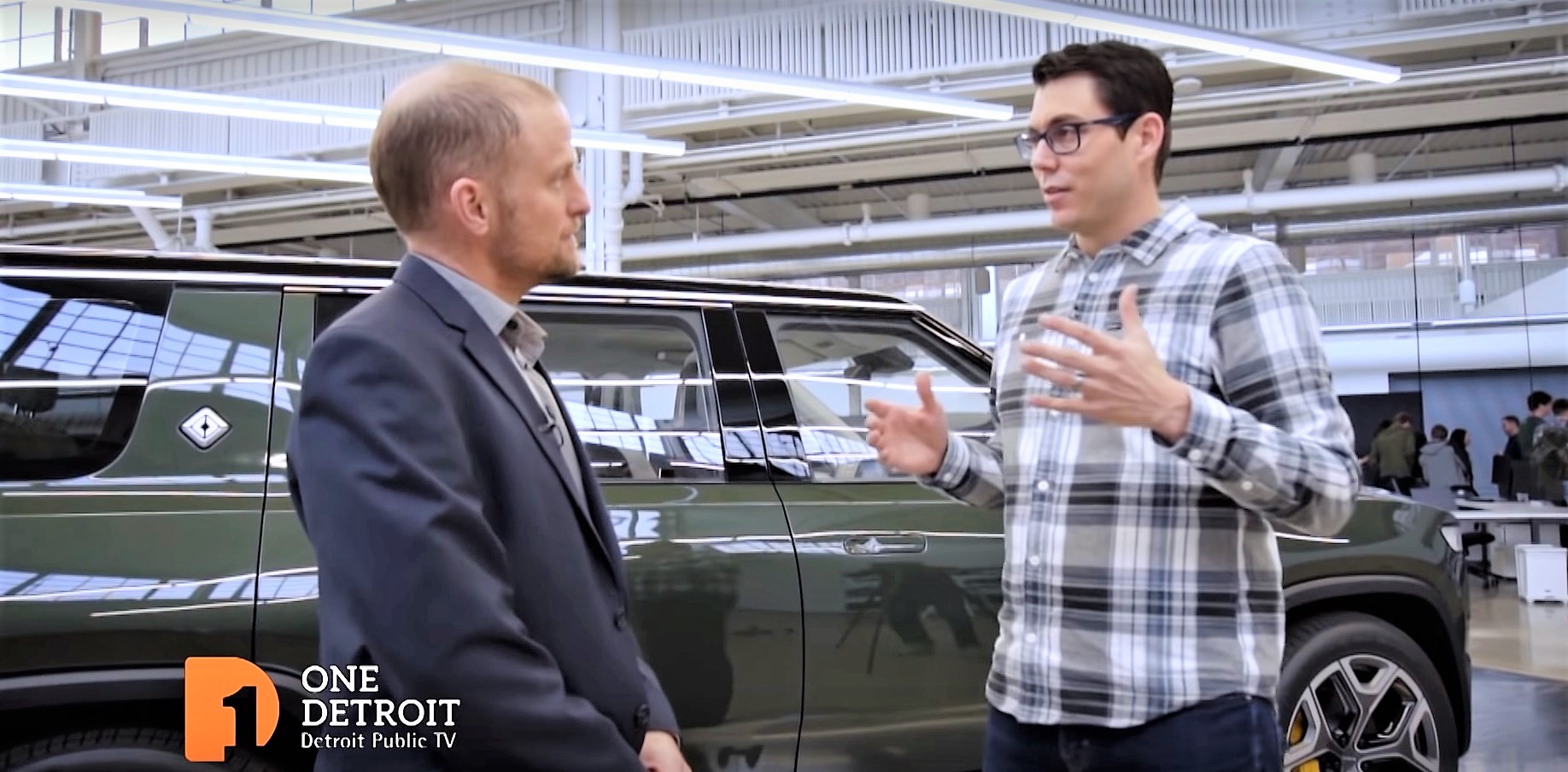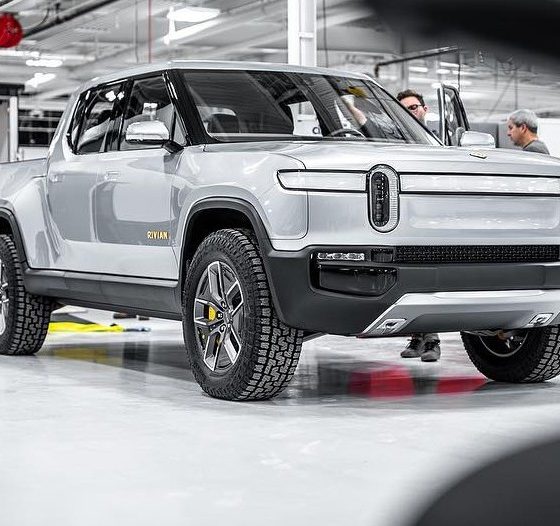Since its debut from the shadows at the LA Auto Show last year, Rivian has been drumming up excitement for its brand of all-electric outdoor adventure vehicles, the R1T truck and R1S SUV. The outdoor adventure company now has its sights set on an appearance at the New York International Auto Show next week where the growing Rivian community and fan base will get an updated look at what’s to come. With this event in mind, Rivian teased another fun photo of its R1T in social media, said to be on the way to New York with a “frunk full of snacks”.
A public TV channel local to Rivian’s Plymouth, Michigan facility, One Detroit, recently had an inside look at what the startup has in the works these days and interviewed founder RJ Scarange as well as few others on the team.
“To give customers a reason to pick a new type of vehicle from a new brand, we need to make something that’s demonstrably better,” Scarange told the interviewer in response to comments about Tesla’s presence as a competitor and the uphill climb facing newcomers in the auto industry. Brian Gase, Chief Engineer at Rivian, expanded on how the company is addressing that goal.

“We want to make sure this can do everything your truck can do. We can tow the 10,000 lbs, we can pull your trailer, we can go up a 100% grade hill because we want you to get out and have an adventure and go see the world,” he said, also pointing to the small details Rivian gives attention to that add up to an overall unique, satisfying experience for an owner.
Gase said his favorite feature of the R1T is the truck’s Gear Tunnel, an equipment storage space that runs the entire width of the pickup truck and is unique to Rivian’s vehicles. Also, he pointed out that the indoor flashlights located inside Rivian car doors are powered by the same batteries that power the vehicles.
The Rivian R1T and R1S are full of compelling, somewhat “hidden” features that add up to a luxury adventure experience aimed at swaying customers over to the company’s brand. Dual LiDAR, a suite of cameras, radar, ultrasonic sensors, and high-precision GPS technologies are already installed in the trucks and SUVs to allow for eventual Level 3 Self-Driving on highways. USB-C ports, 110V outlets, and an air compressor are also included in the R1T beds, all features which would be invaluable to outdoor enthusiasts on biking or camping trips. Combined with a 400+ mile battery range and innovative battery extension packs and modular components, Rivian’s attention to detail seems set to take a very competitive edge against its future peers in the industry.
In a run-up to Rivian’s appearance at the NY Auto Show, reservation holders were invited to attend a private viewing at a local auto club complete with cocktails and greetings by the company’s executives and design team. The building excitement for the brand has since resulted in attendees being grouped into time slots for the viewing due to high attendance expectations. Although production of the R1T and R1S isn’t expected to begin until 2020, the nascent Rivian community is responding well to the company’s marketing efforts to date.
Watch One Detroit’s inside look at Rivian’s Plymouth facility below:

News
Tesla starts showing how FSD will change lives in Europe
Local officials tested the system on narrow country roads and were impressed by FSD’s smooth, human-like driving, with some calling the service a game-changer for everyday life in areas that are far from urban centers.

Tesla has launched Europe’s first public shuttle service using Full Self-Driving (Supervised) in the rural Eifelkreis Bitburg-Prüm region of Germany, demonstrating how the technology can restore independence and mobility for people who struggle with limited transport options.
Local officials tested the system on narrow country roads and were impressed by FSD’s smooth, human-like driving, with some calling the service a game-changer for everyday life in areas that are far from urban centers.
Officials see real impact on rural residents
Arzfeld Mayor Johannes Kuhl and District Administrator Andreas Kruppert personally tested the Tesla shuttle service. This allowed them to see just how well FSD navigated winding lanes and rural roads confidently. Kruppert said, “Autonomous driving sounds like science fiction to many, but we simply see here that it works totally well in rural regions too.” Kuhl, for his part, also noted that FSD “feels like a very experienced driver.”
The pilot complements the area’s “Citizen Bus” program, which provides on-demand rides for elderly residents who can no longer drive themselves. Tesla Europe shared a video of a demonstration of the service, highlighting how FSD gives people their freedom back, even in places where public transport is not as prevalent.
What the Ministry for Economic Affairs and Transport says
Rhineland-Palatinate’s Minister Daniela Schmitt supported the project, praising the collaboration that made this “first of its kind in Europe” possible. As per the ministry, the rural rollout for the service shows FSD’s potential beyond major cities, and it delivers tangible benefits like grocery runs, doctor visits, and social connections for isolated residents.
“Reliable and flexible mobility is especially vital in rural areas. With the launch of a shuttle service using self-driving vehicles (FSD supervised) by Tesla in the Eifelkreis Bitburg-Prüm, an innovative pilot project is now getting underway that complements local community bus services. It is the first project of its kind in Europe.
“The result is a real gain for rural mobility: greater accessibility, more flexibility and tangible benefits for everyday life. A strong signal for innovation, cooperation and future-oriented mobility beyond urban centers,” the ministry wrote in a LinkedIn post.
News
Tesla China quietly posts Robotaxi-related job listing
Tesla China is currently seeking a Low Voltage Electrical Engineer to work on circuit board design for the company’s autonomous vehicles.

Tesla has posted a new job listing in Shanghai explicitly tied to its Robotaxi program, fueling speculation that the company is preparing to launch its dedicated autonomous ride-hailing service in China.
As noted in the listing, Tesla China is currently seeking a Low Voltage Electrical Engineer to work on circuit board design for the company’s autonomous vehicles.
Robotaxi-specific role
The listing, which was shared on social media platform X by industry watcher @tslaming, suggested that Tesla China is looking to fill the role urgently. The job listing itself specifically mentions that the person hired for the role will be working on the Low Voltage Hardware team, which would design the circuit boards that would serve as the nervous system of the Robotaxi.
Key tasks for the role, as indicated in the job listing, include collaboration with PCB layout, firmware, mechanical, program management, and validation teams, among other responsibilities. The role is based in Shanghai.
China Robotaxi launch
China represents a massive potential market for robotaxis, with its dense urban centers and supportive policies in select cities. Tesla has limited permission to roll out FSD in the country, though despite this, its vehicles have been hailed as among the best in the market when it comes to autonomous features. So far, at least, it appears that China supports Tesla’s FSD and Robotaxi rollout.
This was hinted at in November, when Tesla brought the Cybercab to the 8th China International Import Expo (CIIE) in Shanghai, marking the first time that the autonomous two-seater was brought to the Asia-Pacific region. The vehicle, despite not having a release date in China, received a significant amount of interest among the event’s attendees.
Elon Musk
Elon Musk and Tesla AI Director share insights after empty driver seat Robotaxi rides
The executives’ unoccupied tests hint at the rapid progress of Tesla’s unsupervised Robotaxi efforts.

Tesla CEO Elon Musk and AI Director Ashok Elluswamy celebrated Christmas Eve by sharing personal experiences with Robotaxi vehicles that had no safety monitor or occupant in the driver’s seat. Musk described the system’s “perfect driving” around Austin, while Elluswamy posted video from the back seat, calling it “an amazing experience.”
The executives’ unoccupied tests hint at the rapid progress of Tesla’s unsupervised Robotaxi efforts.
Elon and Ashok’s firsthand Robotaxi insights
Prior to Musk and the Tesla AI Director’s posts, sightings of unmanned Teslas navigating public roads were widely shared on social media. One such vehicle was spotted in Austin, Texas, which Elon Musk acknowleged by stating that “Testing is underway with no occupants in the car.”
Based on his Christmas Eve post, Musk seemed to have tested an unmanned Tesla himself. “A Tesla with no safety monitor in the car and me sitting in the passenger seat took me all around Austin on Sunday with perfect driving,” Musk wrote in his post.
Elluswamy responded with a 2-minute video showing himself in the rear of an unmanned Tesla. The video featured the vehicle’s empty front seats, as well as its smooth handling through real-world traffic. He captioned his video with the words, “It’s an amazing experience!”
Towards Unsupervised operations
During an xAI Hackathon earlier this month, Elon Musk mentioned that Tesla owed be removing Safety Monitors from its Robotaxis in Austin in just three weeks. “Unsupervised is pretty much solved at this point. So there will be Tesla Robotaxis operating in Austin with no one in them. Not even anyone in the passenger seat in about three weeks,” he said. Musk echoed similar estimates at the 2025 Annual Shareholder Meeting and the Q3 2025 earnings call.
Considering the insights that were posted Musk and Elluswamy, it does appear that Tesla is working hard towards operating its Robotaxis with no safety monitors. This is quite impressive considering that the service was launched just earlier this year.










